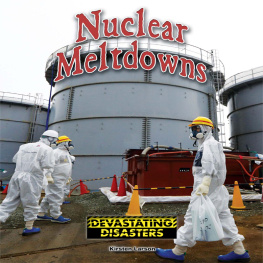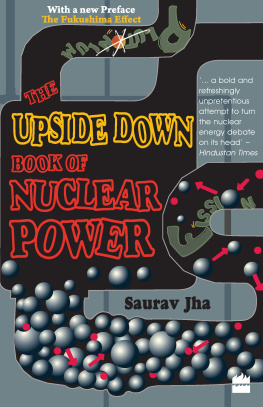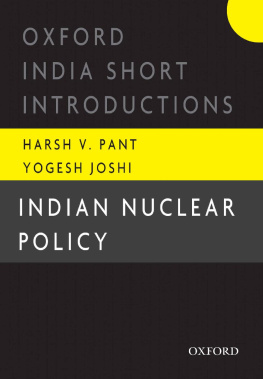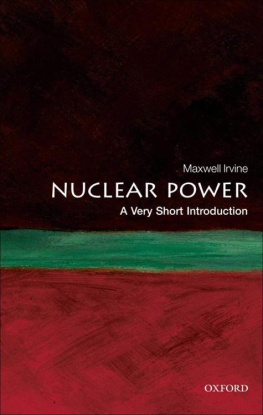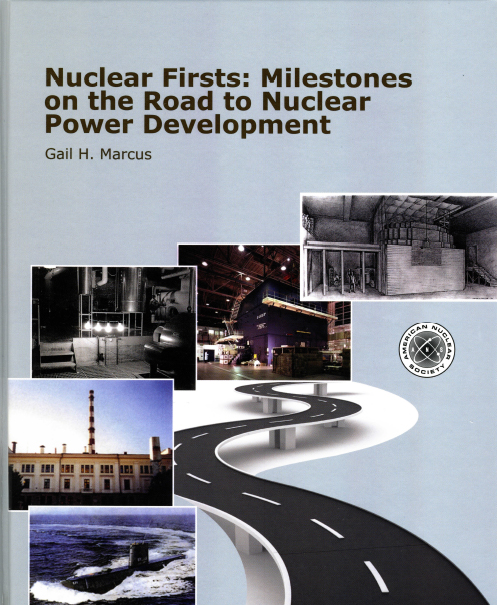

Library of Congress Cataloging-in-Publication Data
Marcus, Gail H.
Nuclear firsts : milestones on the road to nuclear power development/
Gail H. Marcus.
p. cm.
Includes index.
ISBN 978-0-89448-576-3
1. Nuclear engineeringHistoryChronology. 2. Nuclear power plantsHistory-Chronology. I. Title.
TK9146.M328 2010
621.48309dc22
2010028575
ISBN: 978-0-89448-576-3
Library of Congress Catalogue Card Number: 2010028575
ANS Order Number: 690078
2015 American Nuclear Society
555 North Kensington Avenue
La Grange Park, Illinois 60525 USA
All rights reserved. No part of this book may be reproduced in any form
without the written permission of the publisher.
Editorial and production: Quantum Publishing Services, Inc., Bellingham, WA, USA
Typography: Kate Weisel, Bellingham, WA, USA
Printed in the United States of America
I dedicate this book to my parents, Arnold L. and Dorothy K. Halpern, who encouraged both my pursuit of science and my interest in writing.
GHM
FIGURES AND TABLES
FIGURES
TABLES
FOREWORD
G ail Marcuss decision to take on the formidable task of organizing the diverse history of events that have led to todays status of nuclear energy as a technology of renewed worldwide vitality is a most felicitous one. Throughout her career as a technical and management expert in nuclear technology and policy, Dr. Marcus acquired an ideal background for undertaking Nuclear Firsts: Milestones on the Road to Nuclear Power Development. Carrying it off successfully, as she has, required a scholars disciplined dedication to detail as well as a historians ability and courage to decide what need not be included as well as what could not be left out.
Nearly a quarter century ago as a fledgling commissioner of the U.S. Nuclear Regulatory Commission (NRC), I had the good fortune to hire Dr. Marcus as one of my technical assistants. Her work was of great importance in helping me to arrive at a number of difficult regulatory decisions that in retrospect appear to have stood up quite well. Using her careful hard work and insightful analyses, our office developed a set of Principles of Good Regulation that were adopted essentially unchanged by the full commission and even today are cited by staff and commissioners.
Following her time in my office, she held other positions at the NRC before moving to the Department of Energy (DOE) as Principal Deputy Director of the Office of Nuclear Energy, Science and Technology. While in that position she was elected President of the American Nuclear Society. From DOE, Dr. Marcus moved to the Nuclear Energy Agency of the Organization for Economic Co-operation and Development in Paris as Deputy Director-General. Somehow, in the course of all of these experiences, she managed to spend several stints in Japan in various capacities. Through these experiences she developed a broad international perspective that has enabled her to select with confidence the truly important milestone events that are the material of this book.
Nuclear Firsts: Milestones on the Road to Nuclear Power Development covers a historically wide swath of important scientific, technological, and public policy events in the evolution of nuclear power for peaceful purposes. It has only been possible to do this in a single volume of modest size by imposing strict criteria for the selection of events to be included: Each had to be both historically the first and significant for further advances. Wise application of these criteria required a sophisticated knowledge of both the history and the significance of key technological developments. This book amply demonstrates Dr. Marcuss impressive ability to carry that off successfully.
After guiding the reader through a brief review of the seminal discoveries of basic scientists, Dr. Marcus moves to the application of that knowledge in the creation of the technological artifacts we call nuclear reactors. She then traces the evolution of both nuclear power systems and the governmental and other organizations that had to be created to employ them usefully and safely for the public good up to the present.
A book so tightly constructed, while providing much useful information, could easily have turned out to be dull, but with the authors crisp and clear prose and occasional unexpected historical and explanatory tidbits lightly sprinkled throughout, the book is actually absorbing and pleasurable reading.
This is a unique work that is technically sound and includes considerable documentation (where that was possible) for further reading. The author treats very fairly events for which there may be some basis for disagreement as to what or who was the first. She is particularly careful to assign first priority to events elsewhere in the world that preceded developments duplicated in the United States, but were not known about here at that time. She also includes a legacy section for many of the entries in which important developments that grew out of those events are identified.
This is a book that can be read with interest by many different potential readers. Individuals with experience in the nuclear power field could find that it enlarges their understanding of its history. Students and individuals new to the field could find it very useful in providing them with a much better understanding of the origins of the information they may have learned formally and an appreciation of the accomplishments of those responsible for them.
I applaud the American Nuclear Society for publishing the book and Dr. Marcus for creating a significant addition to the list of books that should be candidates for space on the shelves of every professional interested in the field of nuclear power.
Kenneth C. Rogers, Ph.D.
Commissioner, U.S. Nuclear Regulatory Commission, 1987-1997
President Emeritus, Stevens Institute of Technology
PREFACE
T he idea for this book grew during the period when many nuclear facilities and events were reaching their 50-year milestones. As each such event was noted in the press and in discussions at technical conferences, the history began to seem more and more complex. A supposed first would sometimes turn out to have some competitor for the title, and a close examination would suggest that what had been promoted as the first was, in reality, a first with qualifications. It might have been the first demonstration in the United States, or the first plant above a pilot plant size, or the first purpose-built reactor, etc.
These nuances made it appear that there would be value in researching the various claims of firsts and clarifying in what respect each was a first. Although much of this information is already contained in various histories of nuclear power that have been written, no previous attempt has been made to compile all such claims, and none has specifically and consistently addressed the question of which event or facility was first and in what respect.
A further impetus for writing this book is that records of some of the early nuclear research and development efforts have been lost or compromised, and fewer and fewer individuals remain who can fill in the missing pieces. Even now, in conducting the research, it became clear that some historical information is probably irretrievably lost. Therefore, particularly for some of the lesser known events profiled in this book, it is crucial to document as much as possible before further information is lost. Indeed, for the same reason, a task that was expected to be simpleassembling early photographs of each facility profiled in the bookhas proven more difficult than expected. In a few cases, it has not been possible to find an early photograph, or the only ones available were of poor quality. Therefore, in a few cases, small photographs or other historic materials have been used.
Next page


